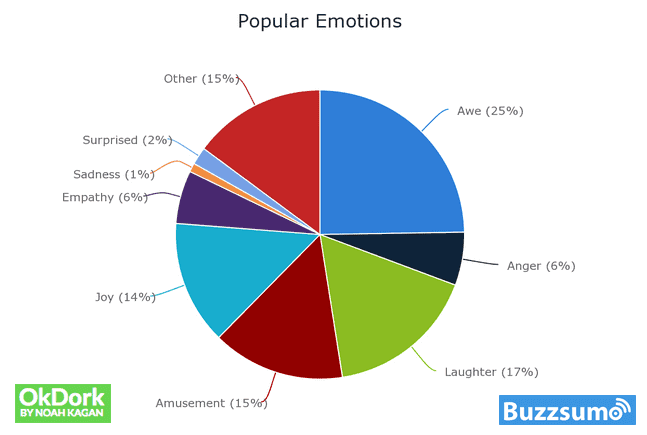Creating an emotional connection with readers through content is one of the most valued skills for marketers and content producers. Many of them know how to give a great advice or an idea to their readers, but much fewer know how to emotionally connect with their audience and get them sucked into their content. That’s too bad, because emotions are an essential part of our lives. Moreover, writing about certain emotions can help your content to go viral. Yes, you read that right. Only certain emotions are effective for establishing that much-needed connection with your audience. What emotions should you use to achieve this goal? To answer this question, we’ll use the evidence provided by research. For example, a recent analysis of 100 million articles completed by BuzzSumo and OkDork found that some of them were more popular than others because they inspired certain emotions. Here are the complete results of their research on emotions: 
These reasons are an excellent source of inspiration to writers because they give them some ideas on topics. Now, let’s see how to use this information to develop a superb content.
[insert page='10-must-have-content-marketing-apps-tools' display='single-related-article-02.php']
Before you begin writing, there’s one important project that needs to be completed: analyzing your readers. Every self-respecting marketer, essay writer, and content producer studies their readers with tools like content personas that include such information as demographics, income, and interests, but we’re going to take that one step further with a psychological profile. This profile should represent your typical reader and contain answers to these questions:
The profile could be strong on family values, so your content should focus on this topic.
Now it’s time to write your content. To maximize the chance of engaging your readers, feel free to take advantage of the following techniques, or emotional “hooks.” Be Real If your content features people, situations, and emotions that you made up for the sake of a higher engagement, your audience will quickly realize this. So no fluff. Be Human Focusing on a product or service that your business sells is a sure-fire way to be ignored. However, if you focus on how your product/service touch your customers’ lives, then it’s a whole different story. For example, take a look at this customer testimonial video by CodeAcademy where a happy customer tells how he was able to transform his career. That’s powerful!
Use Storytelling The video above is also an excellent example of using storytelling, another powerful emotional hook that uses media to communicate a story related to your business. They can be stories about how your customers succeeded thanks to you or how your business helps the community. Play with Controversy Next time you find a controversial topic, consider diving in, especially if you think that it could be interesting to your target audience. Having a strong personal opinion about that topic also helps with content creation. Research and Write About Highly Emotional Topics The most common emotional topics include personal achievement, self-help, goal setting, career advancement, or even entertainment (don’t forget that topics that work for your specific target audience can be different!) Do your research of the most popular content on these topics and brainstorm about unique topics for your content. For example, you can use a content discovery tool like BuzzSumo to identify the best performing content. Let’s suppose that goal setting is a relevant topic to your target audience. Use keywords “How to set effective goals” with BuzzSumo. Here’s the kind of results that you can get.
[insert page='get-a-ringside-view-to-competitive-strategies-with-your-semrush-marketing-toolkit' display='single-related-article.php']
Using emotions is the key to making your content memorable and effective. Try using the tips and tools above to get the reaction you need from your audience with an emotionally powerful content.